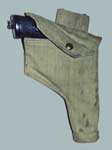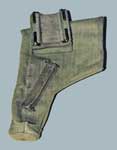Web Holsters used with Patt. '08 W.E.
For the first 27 years of its service life, Patt. ’08 had no webbing holster, at least not for the Rank and File. All that existed was the leather Case, pistol, Webley, with brass hooks, for the issue .455-in Webley, or Pistol No. 1 Mark IV or VI revolver. As a consequence of handling difficulties, during training, the .38-in. Enfield revolver, or Pistol No.2 was introduced in 1932. Its smaller frame easily fitted the existing leather cases, so no immediate provision was made for its carriage.
Stores Ref. A1/AA 0655 CASE, PISTOL, WEB, with brass hooks
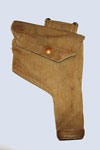
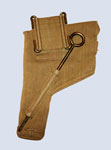
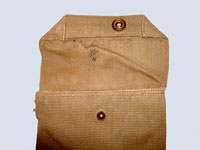 The un-suitability of the leather case was finally addressed when, approved on 28 March, 1935, a smaller Case was announced in List of Changes L. of C. §A8919. The new design was in webbing and was one of Mills’ more unusual designs. In America, the narrower M-1910 belt was eyeleted to accommodate the Mills’ patent “hanger hooks”, by means of which items, including holsters, were suspended from the belt. The Patt. ’08 Belt was much wider and was not eyeleted. M.E.Co. therefore incorporated an articulated joint between the belt “C” hooks and the holster body, which allowed the revolver to hang correctly, rather than protrude, had it been mounted more rigidly to the Belt. This example is maker marked "M.E. Co." and dated 1936. From the Chris Pollendine Collection, photographs © Chris Pollendine 2012.
The un-suitability of the leather case was finally addressed when, approved on 28 March, 1935, a smaller Case was announced in List of Changes L. of C. §A8919. The new design was in webbing and was one of Mills’ more unusual designs. In America, the narrower M-1910 belt was eyeleted to accommodate the Mills’ patent “hanger hooks”, by means of which items, including holsters, were suspended from the belt. The Patt. ’08 Belt was much wider and was not eyeleted. M.E.Co. therefore incorporated an articulated joint between the belt “C” hooks and the holster body, which allowed the revolver to hang correctly, rather than protrude, had it been mounted more rigidly to the Belt. This example is maker marked "M.E. Co." and dated 1936. From the Chris Pollendine Collection, photographs © Chris Pollendine 2012.
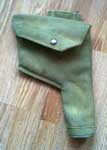

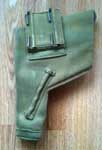
 A patch of doubled thin webbing, carrying a pair of 3 inch brass hooks at each end, was stitched - along its lower edge only - to the back of the body. The shape of the Case was already in existence, having been used with Patt. ’19 W.E., but the reduced size of this holster gave rise to the better known Case, pistol, Patt. ’37 W.E. It should be noted that at no time was this Case ever termed “Patt. ’08 W.E.” and it was made obsolete by L. of C. §C2957, approved on 8th April, 1947. This Case is maker marked "M.E. Co." and dated 1938. The example pictured left is from the Niels Verhagen Collection, photographs © Niels Verhagen 2011.
A patch of doubled thin webbing, carrying a pair of 3 inch brass hooks at each end, was stitched - along its lower edge only - to the back of the body. The shape of the Case was already in existence, having been used with Patt. ’19 W.E., but the reduced size of this holster gave rise to the better known Case, pistol, Patt. ’37 W.E. It should be noted that at no time was this Case ever termed “Patt. ’08 W.E.” and it was made obsolete by L. of C. §C2957, approved on 8th April, 1947. This Case is maker marked "M.E. Co." and dated 1938. The example pictured left is from the Niels Verhagen Collection, photographs © Niels Verhagen 2011.
Stores Ref. A1/AA 0656 CASE, PISTOL, WEB, with loop
List of Changes No. L. of C. §A8919 also introduced this type, which is assumed was for use on B.E. Belts, as no detail was provided. No example of the looped Case has been seen, but it is speculated that the belt loop was attached normally to the Case body and not in the manner of the hooked version. It was made obsolete by List of Changes L. of C. §C2836, approved on 9 Jan, 1947.
Stores Ref. A1/AA 0657 CASES, PISTOL, WEB, R.T.C., with suspension strap and leg strap
Better known by its nickname of “leg holster”, this design excites much attention amongst collectors of Patt. ’37 W.E. They might therefore be surprised to learn that, originally, it was not for use with Patt. ’37, but was intended for Patt. ’08!
Introduced by List of Changes L. of C. §A9730, approved on 24 April, 1936 this was most definitely Mills’ oddest design. The newly named Royal Tank Corps went to “work” sitting down, so it was felt that a holster on the thigh allowed for easier access, rather than one mounted on the belt line. No precise details were given, but first issues evidently differed from later ones. The clue lay within a War Office letter, File Ref. 54 / General / 8220 (M.G.O.9.a), dated 4th August, 1938. This concerned the introduction of Pattern 1937 Web Equipment, but contained a sentence which was not understood at the time. This stated, in reference to the Case, pistol, web, R.T.C. “…These further issues will be of the 1937 pattern, which differs only slightly from the original type…”.Quite what this difference might have been was not stated and no dated examples had then been noted from this early period.
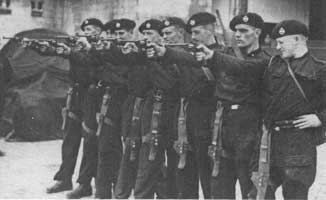
 The solution has now been provided by Allan Prior, who spotted a photograph of a line-up of .38 revolver users at practice (left). This was published in The Royal Tank Regiment. A Pictorial History 1916-1987, by George Forty (Guild Publishing, 1989). Each of the eight pistol cases shown has no cartridge loops, nor a sleeve for a cleaning rod. The Case, pistol, web, with brass hooks carried a rod sleeve on the reverse, so the R.T.C. pistol case may be similarly equipped. Clearly, the “…1937 pattern…” had been modified to have six cartridge loops and a rod sleeve on the front. This is rather more than differing “…slightly…”. The War Office also shows some ambivalence as to nomenclature: it is included in the letter and the Patt. ’37 W.E. pamphlet, but is clearly shown without “Patt. ’37 W.E.” in its nomenclature which, in the event, it acquired only after World War II. The pistol case at right is a genuine example of the first issue.
The solution has now been provided by Allan Prior, who spotted a photograph of a line-up of .38 revolver users at practice (left). This was published in The Royal Tank Regiment. A Pictorial History 1916-1987, by George Forty (Guild Publishing, 1989). Each of the eight pistol cases shown has no cartridge loops, nor a sleeve for a cleaning rod. The Case, pistol, web, with brass hooks carried a rod sleeve on the reverse, so the R.T.C. pistol case may be similarly equipped. Clearly, the “…1937 pattern…” had been modified to have six cartridge loops and a rod sleeve on the front. This is rather more than differing “…slightly…”. The War Office also shows some ambivalence as to nomenclature: it is included in the letter and the Patt. ’37 W.E. pamphlet, but is clearly shown without “Patt. ’37 W.E.” in its nomenclature which, in the event, it acquired only after World War II. The pistol case at right is a genuine example of the first issue.
R.A.F. and Pattern 1908 W.E. Holsters
by R. J. Dennis
The Royal Air Force had its origins in an Army corps, the Royal Flying Corps. The accoutrements it therefore had were “Army” also and principal amongst these was Pattern 1908 Web Equipment. The R.F.C. had two standard issue pistols, the .455-in. Webley Mark VI and the .455-in. Colt Automatic and these were also transferred to the R.A.F..
The Colt Auto was listed as “…1 for each sergeant and above. Except the medical branch and armoured car companies…”. The Webley was correspondingly “…1 for each airman of armoured car units…” (note the use of both company and unit). Just the one holster design existed for these two weapons, 19A/3 Case, pistol, Webley, with brass hooks, which is described under Pistol Equipment in KW’s coverage of Pattern 1908 W.E.
In 1927, blue-grey Pattern 1925 Web Equipment was notified under Section 19A of Air Publication 1086. In the same year, when the full list of components was listed, 'Accoutrements and Steel Helmets' had changed to Section 23. In the new pattern was 23/83 Holster, pistol, Colt (See KW Pattern 1925 W.E. Pistol Equipment). Since Pattern 1925 was only intended for Home Service, it was withdrawn when airmen were posted abroad to Palestine, Iraq and Aden, where the Armoured Car Companies operated. In its place, Equipment, web, drab, 1908 Pattern, as the R.A.F. termed it, was issued and with this only the leather pistol case was provided.
Stores Ref. 23/98 Holster, pistol, Webley, Equipment, web, drab, 1908 Pattern
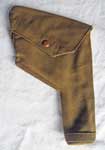
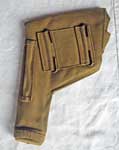
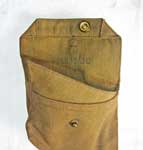 Despite the existence of a .455-in. web holster in Web Equipment for Officers, the R.A.F. unaccountably introduced a modified form around 1936/7. This was based on the Army’s A1/AA 0655 Case, pistol, web, .38-in. revolver, with brass hooks, that had been introduced in 1935 (see above). The off-set crown fastener ensures that the flap is angled, confirming this is a revolver Holster. The Colt Auto holster has its flap more square to the holster body. (See KW Pattern 1925 W.E. Pistol Equipment section)
Despite the existence of a .455-in. web holster in Web Equipment for Officers, the R.A.F. unaccountably introduced a modified form around 1936/7. This was based on the Army’s A1/AA 0655 Case, pistol, web, .38-in. revolver, with brass hooks, that had been introduced in 1935 (see above). The off-set crown fastener ensures that the flap is angled, confirming this is a revolver Holster. The Colt Auto holster has its flap more square to the holster body. (See KW Pattern 1925 W.E. Pistol Equipment section)
Overall, the new Holster was slightly longer, but the 3 inch brass hooks were now rigidly attached to the rear, where the Army used an articulated web chape. It is the other differences that are most distinctive and which are unique, not seen in any M.E.Co. holster design. A web gusset was inserted on the butt side, where the integral weaving normally left a divided section. On the upper edge of the Holster front, under the flap, a triangular piece of webbing was stitched, which extended the front vertically.
It is not known why these inserts were added, as the introductory A.M.W.O. has yet to be found. However, the Holster would now fit more closely round the revolver butt, which must have afforded a slight increase in protection from the ingress of sand. By the same token, the triangular extension would help keep out sand driven under the holster flap. KW will try to confirm these observations.
The Crowned A.M. ownership stamp of the Air Ministry appears above a contract number awarded in 1936.
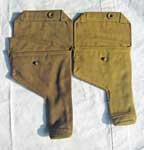
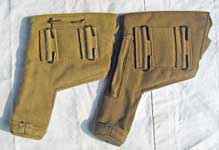 The same Holster, compared with a Patt. '37 Holster made for the 0.38-inch Enfield revolver. Both from the Sean Featherstone Collection, all photographs © Sean Featherstone 2009.
The same Holster, compared with a Patt. '37 Holster made for the 0.38-inch Enfield revolver. Both from the Sean Featherstone Collection, all photographs © Sean Featherstone 2009.
Apart from its unique design features, this Holster has a further unique point. The Army’s holsters for the .455-in. Webley, being leather, obviously could not be “Pattern 1908 W.E.”, but even the web .38-in. revolver holster was not given “Pattern 1908 W.E.” nomenclature. Thus the R.A.F. nomenclature makes this the only official Pattern 1908 W.E. Holster.
Thus far, only one illustration has been noted of this holster in use. This is a Plate 110, of Naval, Marine and Air Force Uniforms of World War 2, by Andrew Mollo (Blandford Press Ltd., 1975). This is a painting, by Malcolm McGregor, taken from an as yet 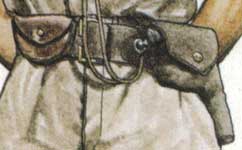 unknown photo, showing a Leading Aircraftman (incorrectly spelled Aircraftsman)) Bob Cook, of No. 2 Armoured Car Company, in Palestine 1939. A web holster - presumed to be this design - is teamed with the leather Pouch, ammunition, pistol, Webley, with brass hooks (See KW W.E. Patt. '08 Pistol Equipment).
unknown photo, showing a Leading Aircraftman (incorrectly spelled Aircraftsman)) Bob Cook, of No. 2 Armoured Car Company, in Palestine 1939. A web holster - presumed to be this design - is teamed with the leather Pouch, ammunition, pistol, Webley, with brass hooks (See KW W.E. Patt. '08 Pistol Equipment).
Note: The paragraph above was correct when Karkee Web first published the writeup on this Holster, but there have been additional developments. See below.
In the R.A.F., this was Stores Ref. 19A/5 Pouch, ammunition, with brass hooks (becoming 23/5 in 1927 and with Webley being added on the end, prior to 1942). Whilst this leather pouch, its shape dating back to Victorian times, was perfectly serviceable, it is curious that no web pouch was ever designed. This would simply have entailed adding 3 inch brass hooks on the Pouch, cartridge, Web Equipment, Naval, Pattern 1919 W.E. (See KW W.E. Patt. '19 Equipment Carriers). In 1938, with the introduction of the .38-in. Webley Pistol No. 2 and a smaller holster for it, the R.A.F. did introduce the Pattern 1919 pouch design, in blue-grey (See KW Pattern 1925 W.E. Pistol Equipment). Perhaps in 1936/7 the budget allowed for a better holster, but would not extend to a web pouch...?! Also not known is whether Braces and Brace Attachments were used. As no Pack was being worn and the weight of revolver and ammunition was not excessive, there was no real requirement for these. However, the R.T.C. had realised that Braces were rather useful in a different role - man-handling a casualty more easily out of a tank, or armoured car.
As ever, KW would now like to team this account with a contemporary photograph. For the R.A.F. Armoured Car Companies, these are not thick on the ground. Of those seen, most are group photos, the emphasis being on the vehicles, not the accoutrements. KW's readers have, in the past, un-earthed some fantastic photos so - over to you.
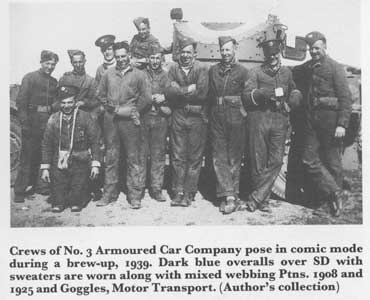 One of Karkee Web's knowledgeable readers
has come up with the information we asked for. Veteran contributor Allen Prior, the same man who located the photo of the 1936 first issue RTC Holster above, has done it again. He spotted the illustration at left in Andrew Cormack's excellent book Men-At-Arms No. 225 The Royal Air Force 1939-45, (Osprey Publishing, 1990) ISBN 0-85045-966-4, which is still in print. Andrew is Keeper of Medals, Uniforms and Visual Arts at the Royal Air Force Museum, London, and is also a member of the Karkee Web Research Team. He is of course pleased to have the equipment in the photo properly identified, and has graciously provided Karkee Web with a high resolution scan of the original photograph from which the illustration in his book was made. The picture at right is from The Royal Air Force 1939-45. Clicking on it will take you to the high resolution photograph (both the book illustration and the hi-res photo are © Andrew Cormack 1990,
used with permission).
One of Karkee Web's knowledgeable readers
has come up with the information we asked for. Veteran contributor Allen Prior, the same man who located the photo of the 1936 first issue RTC Holster above, has done it again. He spotted the illustration at left in Andrew Cormack's excellent book Men-At-Arms No. 225 The Royal Air Force 1939-45, (Osprey Publishing, 1990) ISBN 0-85045-966-4, which is still in print. Andrew is Keeper of Medals, Uniforms and Visual Arts at the Royal Air Force Museum, London, and is also a member of the Karkee Web Research Team. He is of course pleased to have the equipment in the photo properly identified, and has graciously provided Karkee Web with a high resolution scan of the original photograph from which the illustration in his book was made. The picture at right is from The Royal Air Force 1939-45. Clicking on it will take you to the high resolution photograph (both the book illustration and the hi-res photo are © Andrew Cormack 1990,
used with permission).
Karkee Web's close examination of the greater detail in the original photograph has lead to some interesting observations. The pistol Cartridge pouches are confirmed to be the leather Pouch, ammunition, pistol, Webley, with brass hooks (See KW W.E. Patt. '08 Pistol Equipment), as mentioned above. The Belts, also, can now definitely be identified as Patt. '08: the brass slide and part of the distinctive double Twigg buckle of the Patt. '08 Belt can be seen on the man far left. At least one of the men is wearing the Belt, waist, special, from the Patt. '08 Pistol Equipment (for both Belts see the W.E. Patt. '08 Belts page). Look closely at the man fifth from left: just under his left arm one can see one of his Belt's 2-inch rear buckled chapes. It does not have a down tab, which shows that this is a Special waist belt. It seems odd that he is wearing the Belt with its front buckle over his right hip, but it does allow it to be positively identified!
